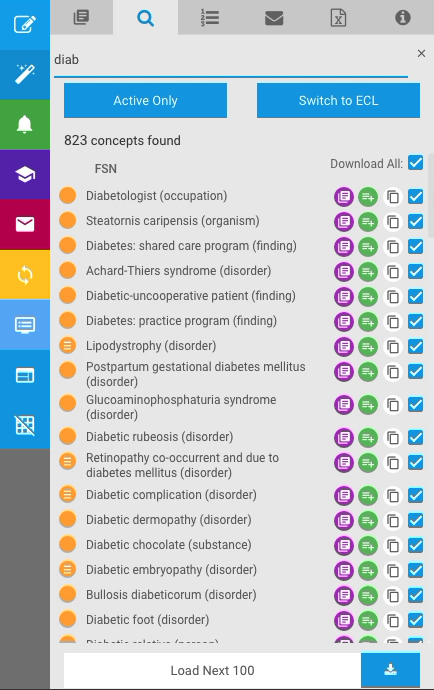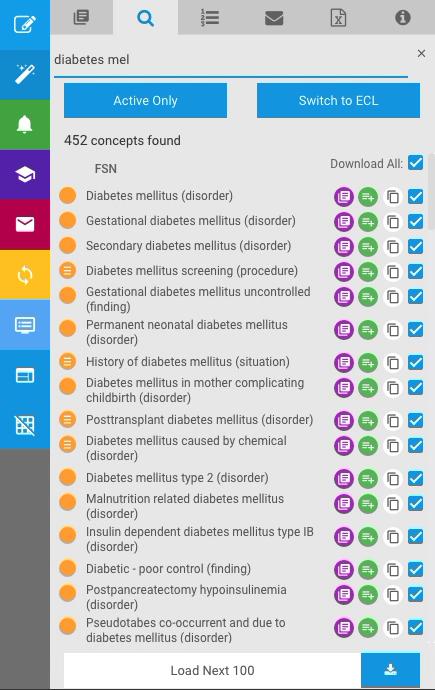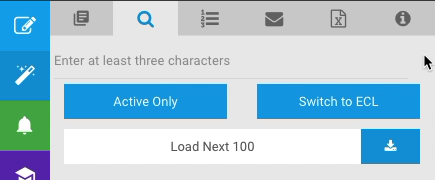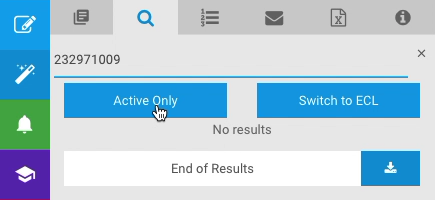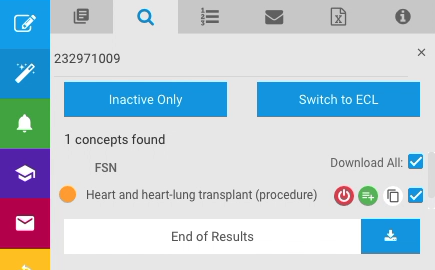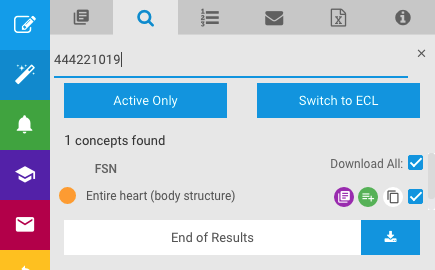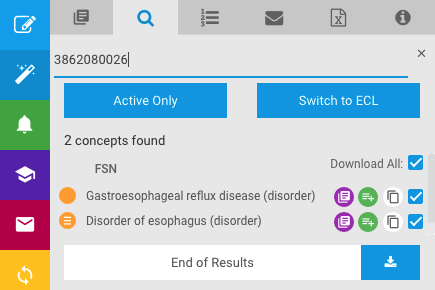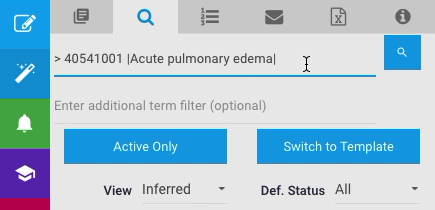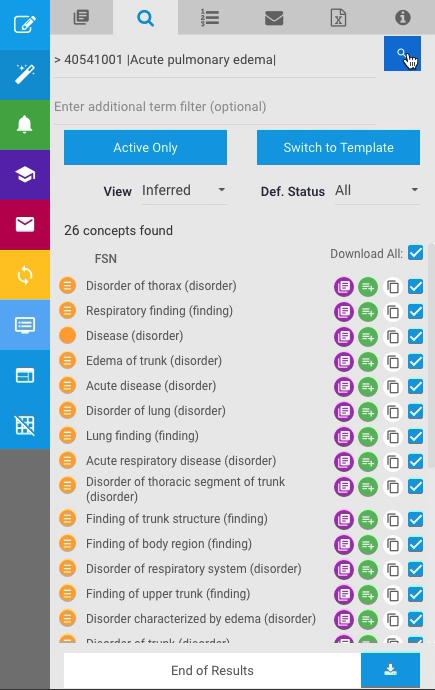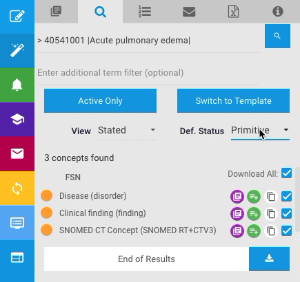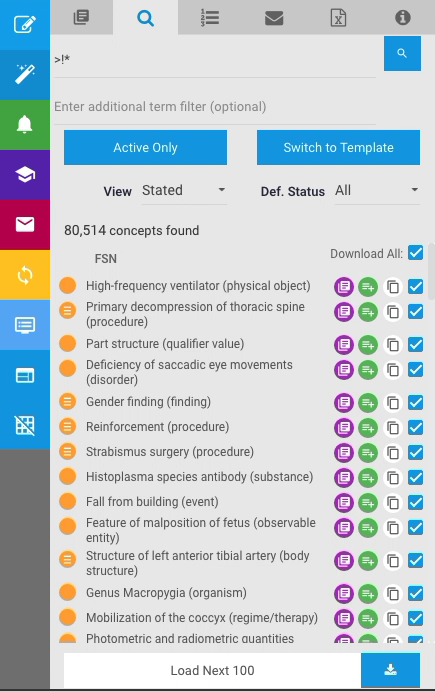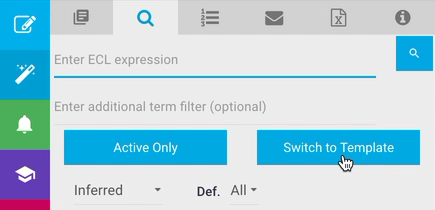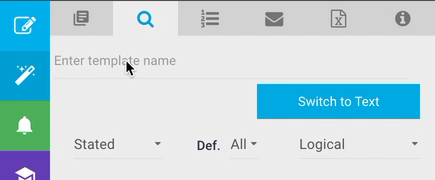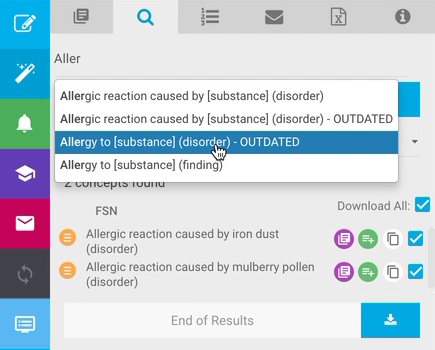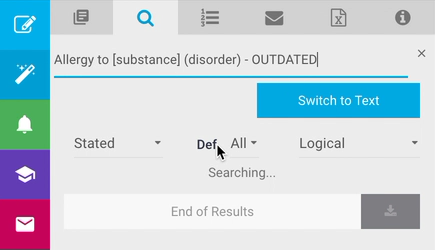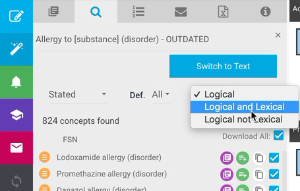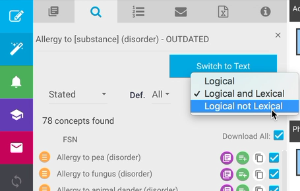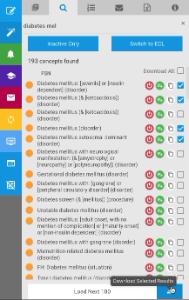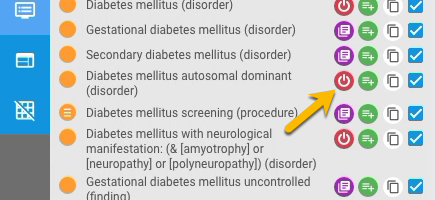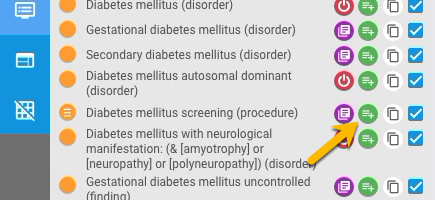Search Options
The Search tab allows you to search SNOMED CT for concept matches to Fully Specified Name (FSN) text patterns, concept and relationship SCTIDs, SNOMED CT ECL expressions, or SNOMED Templates (predefined logical and lexical concept models).
On first opening the tab, a search query text box is presented with a prompt to enter at least three characters. This triggers a text search of SNOMED CT for matches by name or by SCTID. Two large buttons are presented below the search query box - the first is a toggle button for filtering results as Active Only | Inactive Only | Active and Inactive - see the Search Results section below for further details of its use; the second button toggles the search mode from Text Mode (the default setting on opening the Search tab) to ECL Mode.
In ECL Mode, the query box adapts to receive an ECL expression, and an additional term filter box is presented which supports lexical filtering of the ECL expression match results. The Active Only | Inactive Only | Active and Inactive toggle button remains available for ECL Mode to act on the full results set. Note that ECL searches which traverse multiple hierarchies and ranges can take a few seconds to complete and present the results.
From ECL Mode the Switch to Template button switches the search into Template Mode, which presents a type-ahead query box to enter a template name. Templates matching the entered text are presented in a drop-down scrollable list for selection. Picking a template from the list will then return all concepts that conform to the template logical model definition.
In both ECL Mode and Template Mode results can be shown from either the Stated or Inferred view (your most recent setting is remembered by the platform), with further filtering by Definition Status ( All|Primitive|Fully Defined ).
From Template Mode, the Switch to Text button returns to the default Text Mode search.
Search by name
This a standard text pattern match against concept Fully Specified Names (FSNs).
| Steps | Reference |
|---|---|
If previously switched to Template Mode, press If previously switched to ECL Mode, press | |
Enter at least three characters into the search query box. Type-ahead searching starts to present results as soon as 3 or more characters are entered (automatic type-ahead search is not triggered until a slight pause in normal typing). Wildcard characters can be used to elaborate the search query. Asterisk ( * ) matches all subsequent characters regardless of word length. Question mark ( ? ) matches a single character. | |
Entering more characters automatically updates the results set to match the entered text pattern. | |
A clear query X button will appear in the right upper corner of the query box once text is entered. Press this to clear the current query. Standard operating system keyboard select/cut/paste/delete key combinations can also be used to manipulate the query once entered. |
Search by SCTID
This is a numeric exact match to a SNOMED CT concept SCTID; it can be useful for locating newly created concepts. Purely numeric search queries will try to match against SCTIDs, and return an error message if none are found. For example searching for 300 returns "Error performing search: [object Object]: Not Found: Concept with identifier '300' could not be found." To search for a numeric value in an FSN, SYN etc, put quotes around the number or add a wildcard * to the end of the query (eg "300" or 300*). The search will then find matches in text content (including partial matches, so "300" will match "300", "200-300", "300,000" etc.
| Steps | Reference |
|---|---|
If previously switched to Template Mode, press If previously switched to ECL Mode, press | |
Enter a numeric value corresponding to an SCTID into the search query box (no leading or trailing spaces). Cut and paste from another resource is often the easiest way to do this, but the value can simply be typed via the keyboard as for text searches. As for searching by name, once a numeric query is entered the clear query X button appears in the upper right corner of the query box, with the behaviour described above for searching by name. | |
For concept SCTIDs, the single concept matching the SCTID will be found if it exists. Note that unless the results filtering is not currently set to Active and Inactive, a valid search result may be hidden if set to the non-matching status filter. If no results are returned for a known good SCTID when showing Active Only or Inactive Only, then press the button to see the other status filters (eg 232971009 which is an inactive concept, needs the result filtering set to Inactive Only or Active and Inactive to see the search result). | |
| For description SCTIDs, the concept containing the description SCTID will be found if it exists. | |
| For relationship SCTIDs, both the source and target concepts for that relationship SCTID will be found if it exists. |
Search by ECL Expression
For more complex searches, such as locating only concepts within particular ranges or located in particular hierarchies within SNOMED CT, the ECL Mode supports expressions (ECL 1.1.1 since AP Version 2.1.0, ECL 1.3 since AP Version 2.9.0). The steps below illustrate only some basic ECL search examples - please see Expression Constraint Language - Specification and Guide for further reading on the full capabilities of ECL search expressions.
| Steps | Reference | ||
|---|---|---|---|
When in Text Mode (default on opening Search tab), press If previously switched to Template Mode, press | |||
Enter an ECL expression into the search query box. | |||
| Press the Search button to the right of the query box, or press Enter on the keyboard. | |||
| ECL search results can be switched between the Stated and Inferred view, and can also be filtered by Definition Status. These options can be set from drop-down list selectors immediately above the search results list. | |||
After obtaining ECL expression search results, the results set can be refined by entering an additional term filter in the query box below the expression. For example the ECL expression >!* returns all concepts that are leaf nodes. By adding an additional term filter a particular set of matching leaf nodes can be found, such as all leaf nodes containing the word "limb" in their FSN. |
Search by Template
The Authoring Platform includes a set of SNOMED Templates which provide pre-defined logical and lexical models for concepts. Search by Template allows an author to locate concepts which match combinations of the logical and lexical model definitions of a selected template.
| Steps | Reference | ||
|---|---|---|---|
When in ECL Mode , press If in Text Mode, press | |||
Start typing a template name into the search query box. | |||
A list of template names matching the entered text will be displayed as a scrollable drop-down list. Note that some phrases may return many matches, others only one. If no matches are found, the selection list will simply not appear - in these situations, clear the text and enter a different phrase or word stem relevant to the task context. Templates will also be listed when partial words are entered which are found in their names. For example entering "g/d" will list templates such as In most cases the task details should include sufficient contextual supporting information to use for template searching - perhaps even specifying a particular template to match. Current Implementation Details
| |||
Pick a template from the list. The results space will show | |||
The search results will show a list of all concepts which match the template definition. Note the model matching which defaults to Logical only. | |||
Change the model options dropdown selection to search again for
Transformation via Templates When concepts match both the logical and lexical model definitions of a template, then concept transformation to another template pattern is possible. This feature becomes available via the green See Concept Transformation using Templates for further details. | |||
After obtaining Template matches, the results set can be refined by showing those for either the Stated or Inferred view, and also filtered by their Definition Status ( All|Primitive|Fully Defined ). |
Search Results
After using one of the above methods, a list of search results will be presented with concepts matching the search query/expression. The total number of concepts found is shown at the top of the results list. Results can be processed as illustrated in the steps below:
| Steps | Reference |
|---|---|
For Text Mode and ECL Mode searches, press the filter toggle button to switch between | |
For all search types, scroll the results list to see currently displayed results when many matches are returned (for large results sets, only the first 100 are initially loaded in the list). | |
When more than 100 results are found, press | |
In all search modes, the results set can be downloaded for offline inspection and processing. The results can be selectively included or excluded from the download. By default the Download All box is checked, which means the download file will contain all results found (not just those on display). By unchecking the Download All box, particular sub-sets of results can be formed by then checking the individual download options at the end of each result row. In this mode, the selected results are retained when the Load Next 100 is pressed, but the new results displayed will have their download option unchecked, so that the sub-setting process can continue across multiple results loads. Conversely, if Download All is first checked (default on first load of results), and then any results are manually unchecked, smaller sets can be excluded from the download results file. De-selections are also retained when Load Next 100 is pressed, to allow de-selection sub-setting across the entire results set. | |
At any time the currently selected results can be downloaded by pressing the blue download button in the bottom right corner of the search results. The download file is plain text, tab-separated ( id fsn effectiveTime active moduleId definitionStatus pt_900000000000509007 pt_900000000000508004 The last two entries are Preferred Terms (PTs) in the language reference sets relevant to the Authoring Platform instance. For International these are en:us and en:gb respectively. For Managed Service extensions these will be the language reference set PTs relevant to the extension. Search results download constraints
| |
View the definition status of a search result concept via the button icon to the left of its name (FSN). Press the definition status button to open a pop-up box with detailed information about the concept, including Incoming Relationships, Incoming Historical Associations, Concept Details, and (for active concepts) Taxonomy hierarchy location. Incoming Relationships can be filtered on Characteristic Type ( Incoming Historical Associations can be sorted by their SCTID, Concept FSN or Reason. Concept Details include Hierarchy (parent/child concepts), Descriptions and Relationships. Parent, Child and Relationship targets are actively linked to the relevant concept. Following one of these links opens the relevant concept in the same Concept Details pop-up, so contextual associations can be explored without closing the information pop-up box. Once a new concept has been opened via one of these links, the other pop-up box tabs also switch to its context, as if that concept had been opened from the definition status button in a results entry. To get back to the original concept, either reverse traverse back through any links followed, or simply close the pop-up box via the | |
| Press a search result name link to open the concept in the edit panel. | |
When viewing inactive concept results, distinguish such concepts in the results list via their Inactive Concept status icon (active concept results show the View in Taxonomy button here). | |
Press an active concept search result View in Taxonomy button to open the Taxonomy tab with focus set to the search result concept. | |
Press a search result Add to Saved List button to retain the concept for future retrieval via the Saved List tab. | |
Press a search result Clone this Concept button to create a new concept in the edit panel with the same terms and relationships. |




